

Uh oh...
It appears that you're using a severely outdated version of Safari on Windows. Many features won't work correctly, and functionality can't be guaranteed. Please try viewing this website in Edge, Mozilla, Chrome, or another modern browser. Sorry for any inconvenience this may have caused!
Read More about this safari issue.

In the blockbuster movie, Jack Reacher (2012), Tom Cruise’s Reacher extends his hand and introduces himself as “Aaron Ward” to Martin Cash, the shooting range manager. Cash (Robert Duvall), later dubiously suggests that Reacher, “Never played second base for the Yankees.” Cash obviously recognized the name of a former New York Yankees star, Aaron Ward. Most of the millions who saw the original movie of the Cruise-Reacher series did not.
Aaron Lee Ward was born in Booneville, Arkansas, on Aug. 2, 1896. Like most of the young men of his day with advanced baseball talent, he came of age playing on the local men’s teams. By the time he arrived at Ouachita College for the 1913–1914 school year, his defensive skills were already getting the attention of sportswriters. In his first game with the Ouachita Tigers against a local all-star team, the “Arkansas Gazette” predicted, “Though but 17 years old, Ward promises to be the classiest fielder ever brought to this institution.”
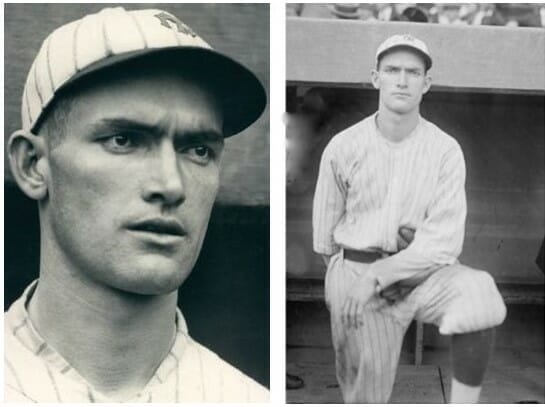
The sports writer’s compliment about Ward’s glove work failed to mention that the hitting part of his game was far less laudable. The summer after his second year at Ouachita, Ward was playing in a summer semi-pro league in Warren, Arkansas, when a lack of late-season choices, led the Little Rock Travelers to sign him for the last month of the season. In his 18 at-bats for the Travs, Ward went 0–18 at the plate, doing nothing to indicate he could hit professional pitching. Little Rock gave up quickly and sold their replacement shortstop to Montgomery in the Class C South Atlantic League.
Aaron Ward was not considered a major league prospect despite being what baseball men called a good “glove man,” but the last years of the 20th century’s second decade were not the usual pro baseball environment. A pandemic called the Spanish Flu had greatly diminished the player pool due to illness, and an increasingly dangerous conflict in Europe resulted in a military buildup that decimated pro baseball rosters.
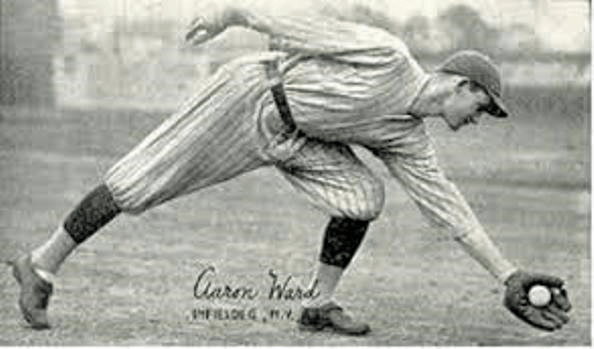
Aaron Ward was known as an excellent defensive infielder.
After two unremarkable years in the low minor leagues, the depleted New York Yankees signed the weak-hitting glove man as a backup infielder in the late summer of 1917. Aaron Ward was a major league baseball player, albeit due to the Yankees’ desperation. Reacting to the news that the former Little Rock shortstop had signed with New York, the “Arkansas Gazette” recalled Ward’s stint with the Travs, “He put up a classy game at short, but he couldn’t hit at all.”
In 1918 and 1919, Aaron Ward was the prototype of a utility player—perhaps the term “emergency player” would have been a better description. He played a combined 47 games for the Yankees in the two seasons, and despite his reputation as a glove man, he played in the field only 29 times. His combined batting average as a Yankee for 1917–1919 was a dismal .152. Ward was in the major leagues because of his glove work and the player shortage. He was at the end of the bench because he apparently could not hit big-league pitching.
Those descriptions were about to change drastically. Signed by Little Rock because of a player suspension and promoted to the Yankees because of a pandemic and the military buildup in World War II, Ward was about to receive another promotion due to a series of unfortunate circumstances.
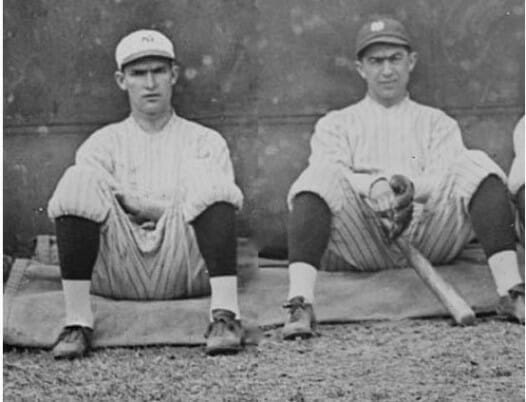
Aaron Ward and Frank “Homerun” Baker
The Yankees’ iconic third baseman Frank “Homerun” Baker lost his wife to pneumonia on February 12, 1920, and he elected to stay home and care for his young daughters, leaving New York looking for a replacement for one of the game’s top third basemen. Unable to pull off a last-minute trade, the Yanks gave the job to their utility man, Aaron Ward, out of necessity.
In the first three months of the season, Ward met only the Yankees’ modest expectations. He struggled at the plate but handled the unfamiliar hot corner well enough. The Yanks anticipated a light-hitting temporary caretaker for Home Run Baker’s position, but by mid-season, Ward seemed to adopt a more aggressive hitting strategy that he may have learned by observing his new teammate, Babe Ruth.
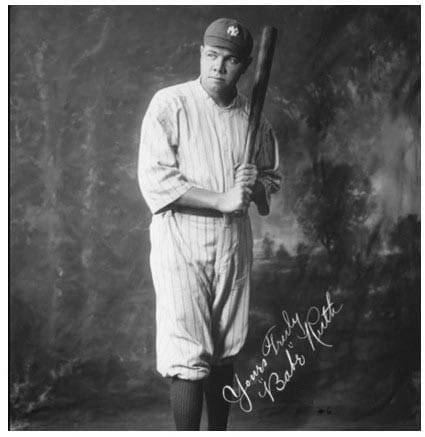
The Babe hit 54 home runs in 1920, more than the combined roster of any other American League team. In an amazing second half of the season, Ward more than doubled his first-half extra-base hits. His 11 homers for the season would tie for second on the team and seventh in the American League. Out of nowhere, a star was born in a city that loved the Yankees. “The New York Herald” declared, “Aaron Ward of the Yankees hits a ball as hard as any young player in many a day. He is a swinger from the end of his bat, and he belts them far and swiftly.”
Beginning in 1921, Ward no longer needed to look at the card posted in the dugout to see if he was in the lineup. He led the team in games played and raised his batting average to an improbable .306. More in line with expectations, his defense was outstanding. Despite moving to second base on Baker’s return, Ward was third among the league’s second sackers in assists and fielding percentage.
Although his batting stats fell off somewhat in 1922, Ward led the Yanks in games played, and at age 25, he secured his reputation as the league’s top defensive second baseman. In his second season in a new position, he was second in the league in fielding percentage, and first in assists. The Yankees won their second consecutive American League pennant but lost the World Series to the cross-town New York Giants.
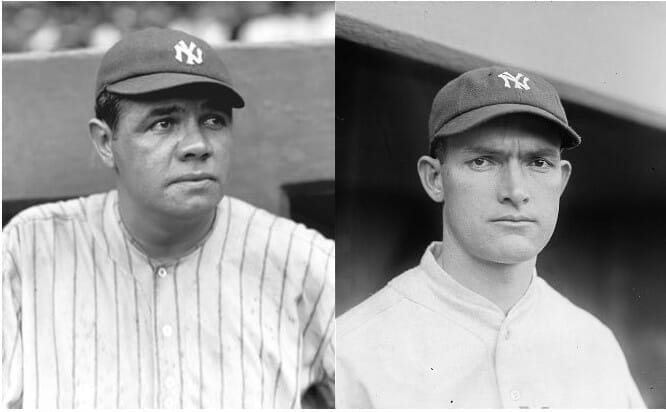
Babe Ruth 1923 and Aaron Ward 1923
The 1923 season opened in the Yankees’ new ballpark on April 18, with an announced attendance of 74,000 and another 25,000 left outside. In the home half of the third inning, the fans got what they came for. A 26-year-old second baseman from Booneville, Arkansas, hit a sharp single between short and third for the first hit in Yankee Stadium. Later in the inning, right on script, Ruth hit the first home run in the new park. Ward got a box of cigars for his inaugural hit, and the Yankees started the season with a 4–1 victory in what would become the year the New York Yankees began the ascension to legendary status.
In the fall, the Yanks won their first World Series of the 20th century, beating their cross-town rivals, the Giants, four games to two. Ward hit .417 in the World Series, leading the team in most hits, and fielding a ground ball to second to end the series and initiate a New York celebration that lasted for weeks.
Newspapers reported that back in Booneville, Ward’s friends and family followed the exploits of their famous favorite son. The “Arkansas Gazette” reported, “Every move of the World Series was received by scores of anxious fans in Booneville over the radio, and it is useless to say that every time our ‘Wardy’ made a hit or scored a run, the folks over in the next county knew it by the cheers.” Aaron Ward and the “Bronx Bombers” had reached the pinnacle of baseball success, but the summit of the baseball world is a slippery slope.
The year after the Yankees’ series triumph, knee problems that had haunted Ward’s career since his football days at Ouachita returned, and the Yanks faded to second place in 1924 and seventh in 1925. They would recover to build another Ruth-led Bronx Bombers team in the last half of the decade, but they would build their new “Murderers Row” image without Aaron Ward.
After he played in only 22 games in 1926, the Yankees traded their injury-prone second baseman to the Chicago White Sox, where he finished his big-league career two years later. Ward played a few more minor league seasons, and by the early 1930s, he was playing for a semi-pro team in West Texas. He moved to New Orleans after his retirement, opened a tire store with his son, and became one of the city’s prominent amateur golfers. Aaron Ward died in 1961.
The story of the rural Arkansas glove man who once starred along with Babe Ruth on the Bronx Bombers has faded from baseball lore. Despite his stardom in the big leagues, Aaron Ward has yet to be selected for the Ouachita Baptist University Hall of Fame or The Arkansas Sports Hall of Fame.
As the 2023 season gets underway, it is an appropriate time to remember the season 100 years ago when Arkansas’ Aaron Ward was a star on baseball’ biggest stage.
Note: A comprehensive biography of Aaron Ward and more than 60 other stories from the years when baseball was Arkansas’ Game will be featured in Hard Times and Hardball, Jim Yeager’s second book on Arkansas Baseball history, coming in May to Petit Jean Coffeehouse and www.backroadsballplayers.com.
Header Photo: 1923 New York Yankees World Series Champions, Babe Ruth, eighth from left standing, Aaron Ward, middle row fourth from right.
We do the work.
You check your email.
Sign up for our weekly e-news.
Get stories sent straight to your inbox!









Like this story? Read more from Jim Yeager
For most of the 1964 season, the Arkansas Travelers were the best team in...
At 11:53 p.m. on June 1, a crowd of 11,000-plus at Alex Box Field fell...
Baseball Hall of Famer Bill Dickey was born in Bastrop, Louisiana, on...
Join the Conversation
Leave a Comment